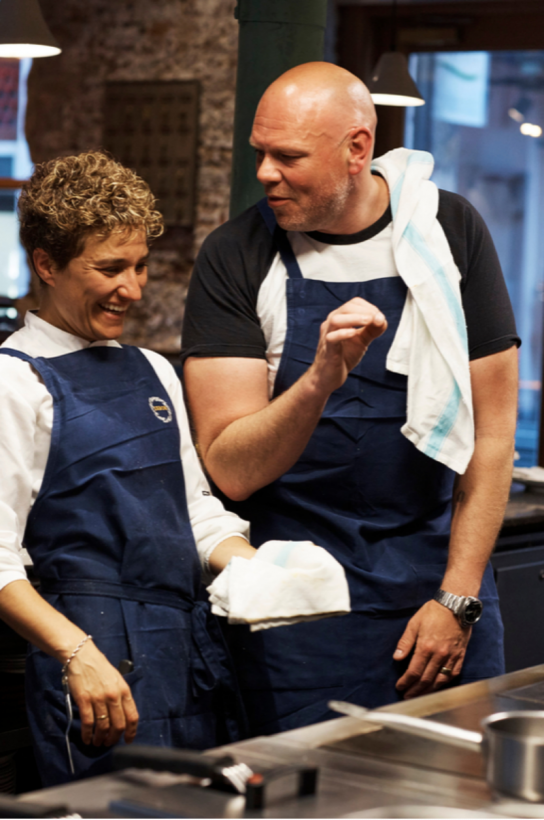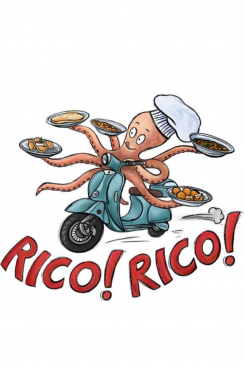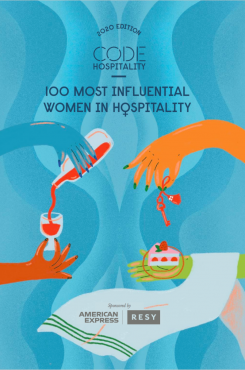Even when you’re a Michelin-starred chef you never stop learning. So when Tom Kerridge heard that Lisa Markwell was having a Spanish tortilla masterclass from Nieves Barragán Mohacho, he joined in. Here’s what happened at the Sabor stoves…
Photographs by Harriet Raper
One recent afternoon, while the staff were off on their afternoon break, we met up at the groundfloor open kitchen of Sabor, for Nieves to teach us the secrets of the classic Spanish tortilla. It’s been a menu favourite since day one and everyone who eats this dish admires the perfect disc of tender set egg and rich, runny filling. Set up on the counter, a gastro with supersoft, caramelised sliced onions, another filled with peeled potato sliced into pieces about the size and thickness of 50p and boxes of St Ewe rich yolk eggs. We put on Sabor aprons and gulp down a large coffee. Let’s go to work…
Tom: The simplest food is what I love best. The reason why we are here is because Nieves’s tortilla is the best tortilla – world class – and I want to know how to make it. It’s just onion, potato and eggs, but it’s the technique and the skill. That’s what makes something so simple so beautiful and amazing. I need to see how to do it.
Nieves: OK, I only do two types of tortilla and I was taught by my mum. And everyone has eggs, onion and potato in their house. Here we just look after the ingredients – good Spanish onions, good eggs and Chippies Choice potatoes.
Tom: Ah, yes, nice and waxy and they hold their shape. That brand do the work on the sugar and starch content to find the perfect potato that works for frying. They are expensive and because through the season, the starches change, the company buys different varieties from different areas that fit that criteria so you can get the same results every time.
Nieves: Never rinse the potatoes, we want the starch. And we don’t fry them in advance, it’s always for service. Although you can cook those onions in advance, in olive oil very long and slow.
Lisa: That’s one of my biggest bugbears, recipes that lie and say you can caramelise onions in 10 minutes!
Tom and Nieves: YES!
Tom: I hate it. The onion one is really bad, the other one is pastry – when they say ‘blind bake the pastry tart 15-20 minutes’… What do you mean 15-20 minutes???!!!!! The oven’s on 150 degrees, so maybe 45 minutes if you’re fucking lucky!
Nieves: Back to work. I want to cook those potatoes a batch at a time in grapeseed oil, they need to have a little ‘skin’, a little texture.
Tom: And where’s that oil from, Nieves? England? YEAH! [Laughs]. It’s almost like the first fry of triplecooked chips – to eradicate moisture but still keep texture.
Nieves: Yes. Tortilla is something that takes time to do, you know? A series of processes. You can’t rush it. But those eggs, you need to whisk them only enough to just break them up, don’t overwhisk or they will go watery. And if that happens, the potato just won’t absorb the egg – and the tortilla will have no body.
Tom: When we make our lobster omelettes at the Hand & Flowers, we take the eggs, crack them into a container and hand blend them, break them down completely.
Nieves: [gasps] Don’t do that!
Lisa: When we made egg dishes at Leiths, we had to sieve the egg to get rid of the chalaza…
Tom: Chalaza? How’d you know that?!
Nieves: OK so once you’ve fried those potatoes till they are golden, you drain them, season them a little and then so you take one part onion to three parts potato and mix it, then add the beaten egg a little at a time while the potato is warm, then you let it rest and ‘set’ for 20 minutes. You want to see some foam appearing.
Lisa: Who knew you had to wait?
Nieves: It has to absorb [makes a sucking noise and laughs]. You know, to become… what’s the word?… unctuous! That’s the key. And a little white pepper – always only white. During the 20 minutes resting time, we look through the extensive collection of frying pans – from individual ones for use at the Sabor counter to midsize for sharing tortillas up in the Asador, and even larger.
Tom: I like the most battered old ones, with the handles that are about to break off. Nieves: That’s sexy!! You just need to get it hotter and use more oil. Tom: So the egg and potato have become friends.
Nieves: So the trick is to have the pan hot but not too hot [she tests the olive oil with her finger, typical chef ’s Teflon hands], and you must load the mix right to the top of the pan and be careful to keep the edges neat.
Lisa: This makes me nervous – how do you know when it’s done enough?
Nieves: The edge should be set and lose its whiteness, but you don’t want too much colour.
She takes a clean saucepan lid, inverts the tortilla onto it and carefully slides it back into the pan without the edge losing any definition – it’s clear she has done this a thousand times before. She shows us how to smooth the surface of the tortilla with the back of a spoon but to tell by touch when it is firm enough but not hard.
Nieves: You must feel it, and smell it.
The three tortillas are ready. Turned out onto a plate and eaten standing up with a spoon, they are ambrosial.
Nieves: Sexy! I’ve loved teaching you this, it’s fun. They are not the best today, we’ve been talking and I’m distracted…
Tom: It’s not fucking bad, chef ! Tom: It’s all about the methods, the technique. The little idiosyncrasies that the guests don’t know about – they eat the tortilla, and ask themselves, ‘how is it so good?’ Right, now that we know this, what else can we do? Let’s do sushi, let’s to go A Wong. Let’s go and see what Claude does with frogs’ legs…
And we go our separate ways, with plans to make this a regular event, an ever-growing ‘chain’ of chefs learning each other’s skills and gaining expertise in new cuisines. Where next?
This article was first published in Issue 19 of CODE Quarterly.



